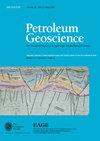罗萨诺-圣尼古拉断裂带演化影响了意大利卡拉布里亚弧克罗托内盆地的埋藏和成熟历史
IF 2.1
4区 地球科学
Q3 GEOSCIENCES, MULTIDISCIPLINARY
引用次数: 4
摘要
这项工作探讨了意大利南部卡拉布里亚弧北西-东南走向走滑断层带Rossano San Nicola断层带(RSFZ)的构造意义。勘探钻孔和伪井的高质量地震反射和1D正演模型表明,RSFZ经历了多个中新世收缩/转挤压构造阶段。随后是上新世地壳伸展,与第勒尼安海的海洋化、亚平宁造山运动以及卡拉布里亚弧与相邻构造板块之间的碰撞有关。这种环境对克罗托内盆地及其经济潜力产生了深远影响:1)构造复活使克罗托内流域的储层单元受到来自三叠纪/下侏罗纪烃源岩的天然气的充注,2)烃源岩在上新世大型物质运输杂岩侵位后达到最大深度并保持在天然气生成窗口中。在周围地区,RSFZ附近的构造活动通过提高局部沉积速率,特别是在Langhian(中新世中期)和Zanclean(上新世早期)构造期间,有助于源岩成熟。这项工作很重要,因为它证明了克罗托内盆地的构造-地层演化与RSFZ的结构演化密切相关。至关重要的是,该研究区域揭示了第一个由大型质量传输复合体完全密封的气田的例子。因此,我们将克罗托内盆地晚新生代地质史与地中海中部地区(即爱奥尼亚海和第勒尼安海)的地球动力学演化联系起来。我们确定了克罗托内盆地的新前景,并为意大利南部的天然气生成和聚集提供了时间框架。本文章由计算机程序翻译,如有差异,请以英文原文为准。
The Rossano-San Nicola Fault Zone evolution impacts the burial and maturation histories of the Crotone Basin, Calabrian Arc, Italy
This work addresses the tectonic significance of a NW-SE strike-slip fault zone in the Calabrian Arc of Southern Italy, the Rossano-San Nicola Fault Zone (RSFZ). High-quality seismic reflection and 1D forward models of exploration boreholes and pseudo-wells show that the RSFZ experienced multiple Miocene phases of contractional/transpressional tectonics. These were followed by crustal extension during the Pliocene in association with the oceanisation of the Tyrrhenian Sea, Apennine orogenesis, and collision between the Calabrian Arc and adjacent tectonic plates. Such a setting had a profound influence on the Crotone Basin and its economic potential: 1) tectonic reactivation allowed reservoir units of the Crotone Basin to be charged by gas derived from Triassic/Lower Jurassic source rocks, and 2) source rocks reached their maximum depth and remained in the gas generation window after the emplacement of a large mass-transport complex in the Pliocene. In the surrounding areas, tectonic activity near the RSFZ contributed to source-rock maturation by enhancing local sedimentation rates, particularly during Langhian (Middle Miocene) and Zanclean (early Pliocene) tectonics. This work is important as it demonstrates the tectono-stratigraphic evolution of the Crotone Basin to be closely related to the structural evolution of the RSFZ. Crucially, the study area reveals the first example of a gas field fully sealed by a large mass-transport complex. As a corollary, we tie the Late Cenozoic geological history of the Crotone Basin to the geodynamic evolution of the central Mediterranean region, namely the Ionian and Tyrrhenian seas. We identify new prospects in the Crotone Basin and provide a time frame for gas generation and accumulation in Southern Italy.
求助全文
通过发布文献求助,成功后即可免费获取论文全文。
去求助
来源期刊

Petroleum Geoscience
地学-地球科学综合
CiteScore
4.80
自引率
11.80%
发文量
28
审稿时长
>12 weeks
期刊介绍:
Petroleum Geoscience is the international journal of geoenergy and applied earth science, and is co-owned by the Geological Society of London and the European Association of Geoscientists and Engineers (EAGE).
Petroleum Geoscience transcends disciplinary boundaries and publishes a balanced mix of articles covering exploration, exploitation, appraisal, development and enhancement of sub-surface hydrocarbon resources and carbon repositories. The integration of disciplines in an applied context, whether for fluid production, carbon storage or related geoenergy applications, is a particular strength of the journal. Articles on enhancing exploration efficiency, lowering technological and environmental risk, and improving hydrocarbon recovery communicate the latest developments in sub-surface geoscience to a wide readership.
Petroleum Geoscience provides a multidisciplinary forum for those engaged in the science and technology of the rock-related sub-surface disciplines. The journal reaches some 8000 individual subscribers, and a further 1100 institutional subscriptions provide global access to readers including geologists, geophysicists, petroleum and reservoir engineers, petrophysicists and geochemists in both academia and industry. The journal aims to share knowledge of reservoir geoscience and to reflect the international nature of its development.
 求助内容:
求助内容: 应助结果提醒方式:
应助结果提醒方式:


